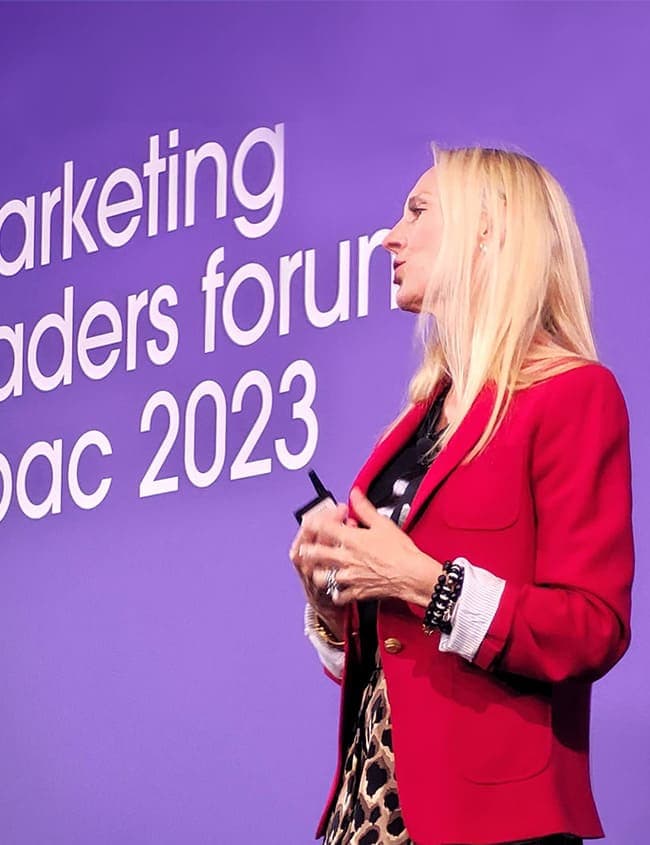By embracing data and technology, we can make strategic decisions based on insights rather than instinct. Latané Conant, Chief Market Officer at 6sense
At a recent intimate lunch hosted by Green Hat at Cumulus, Melbourne, a cohort of eminent marketers and business leaders from McCain, Real Estate Group, Bega, RMIT, Viva Energy (Shell), and cyber security leader Mimecast enjoyed a rare opportunity to meet and talk shop.
Between the lively chatter and the clinking of cutlery, an important conversation was underway. At the heart of the discussion was Latané Conant, Chief Market Officer at 6sense. For those unfamiliar, 6sense is a leading player in account-based marketing, leveraging artificial intelligence and big data to transform the B2B marketing landscape. Latané, with her innovative ideas and transformative strategies, is a thought leader shaping the future of the sector.
The event, organised by Green Hat, aimed to connect local B2B businesses with progressive marketing strategies and continued with engagements in Sydney, culminating in the B2B Marketing Leaders Forum, APAC’s largest B2B marketing community and conference where the agency and Latané headlined.
Returning to our lunch in Melbourne, Latané generously shared insights and lessons from her extensive experience. I want to share three key ideas that deeply resonated with the group: pre-intent, multi-threading, and the evolution of the CMO role.
1. Pre-intent: Reading the Market’s Mind
When Latané speaks about ‘pre-intent,’ you can’t help but feel that you’re entering a scene straight out of the Minority Report. Distinct from intent data, which shows what a prospect is already demonstrating interest in, pre-intent data unveils early hints, enabling marketers to predict a prospect’s forthcoming decision, possibly even before the prospect themselves is fully aware of it.
Consider a business that has been researching ways to improve their data management efficiency, without having explicitly expressed interest in a specific data centre or technology solution. This is where pre-intent data can come in. Instead of focusing on explicit signs of intent such as first-party data from their website interactions, or third-party data bought or aggregated from external sources, pre-intent data examines other cues.
This might involve observing their other business activities, like their recent purchases or job postings related to data management. It might also mean analysing what they’re sharing publicly, whether they’re posting blogs about the challenges of data management or sharing relevant content on social media. All these signals can suggest that the business is positioning itself to take the next logical step—perhaps moving towards a cloud-based data centre solution.
For instance, let’s imagine the business has been hiring experts in cloud migration, or their CEO has been posting articles about the benefits of digital transformation. These could be pre-intent signals indicating they’re considering a transition from their outdated on-premise data centre to a more modern, cloud-based solution. By paying attention to these subtle hints, marketers can anticipate and meet the needs of their prospects even before they fully manifest.
2. Multi-threading: Weaving the Web of Influence
Next on the table was the concept of ‘multi-threading,’ which is not a new term for B2B sales, but it is one that carries great importance. This approach involves identifying, engaging, and influencing multiple stakeholders within a prospective account. “At 6sense,” Latané enthuses, “if the opportunity has less than three engaged stakeholders, it’s not an opportunity yet.”
And how do we identify these stakeholders? Latané was concise: “B2B decision-making involves a web of stakeholders, not a single point of contact. Identify them, understand their roles, and tailor your communication to their needs.”
She illustrated how sales and marketing teams need to work together for multi-threading to be effective. While sales teams map out and engage with this complex web of decision-makers, marketing teams provide the content that resonates with each stakeholder’s unique concerns.
Take that company seeking a new data centre solution as an example. The IT manager may be interested in technical specs and scalability, the CFO in cost-efficiency, and the CEO in overall business impact. By sales engaging all these stakeholders and marketing crafting personalised messaging, they increase their chances of winning the account. This synergy between sales and marketing, Latané emphasised, is the essence of multi-threading.
Our marketing strategy and partner integration with 6sense help uncover these buying committees. For a live case study, look no further than 6sense’s blog on multi-threading in sales.
3. CMO to CMO: The Evolution from Chief ‘Marketing’ Officer to Chief ‘Market’ Officer
Latané touched on this subtle but significant shift in her professional title; she pointed out that the title of Chief’ Market’ Officer signifies more than a semantic adjustment—it implies a paradigm shift in focus and responsibility. Unlike a Chief ‘Marketing’ Officer, who might primarily concern themselves with campaigns and ads, a Chief ‘Market’ Officer possesses a broad, all-encompassing perspective on the market environment.
Incorporating insights from real estate to tech to energy sectors, a Chief Market Officer thinks beyond marketing tactics. They obsess over understanding the market trends, customer behaviours, competitor strategies, and changes in the broader business environment. After all, the board might show minimal interest in the details of the latest marketing campaign, but they certainly care about the state of the market and how the company is positioned within it.
To Latané, this title change is a call for leaders in sales and marketing to adopt an account-based approach that is more in tune with the overall market landscape. “We have a chance to reinvent the traditional roles of marketing and sales, and after all; marketers are more than just an MQL”.
However, she emphasised that a simple title change was not the end goal—it’s the transformation that comes with it that matters. This involves a comprehensive reconsideration of the role, which extends from strategy formulation to execution.
The Chief Market Officer needs to be the nexus of customer insights, sales strategies, and market trends, becoming the driving force behind an integrated, market-focused approach. They should have the pulse on every aspect of the market—from shifts in customer preferences to technological advancements, ensuring that the company’s strategies align with the evolving market realities. By doing so, they help to position the company at the forefront of market trends, leading to sustainable competitive advantage.
Our B2B marketing attendees echoed this sentiment. One marketing director reflected, “Changing from ‘Marketing’ to ‘Market’ underlines the need to understand and serve the market as a whole. It’s about comprehending the buying groups, numbers, risk reduction, and buying committees. It’s a massive shift.”
Embracing Change: Navigating the Uncertainties of Progressive Marketing Strategies
Admittedly, embracing such a substantial shift may stir uncertainty, particularly in an environment filled with economic unpredictability and high-stakes ROI expectations. Amid these progressive strategies, our guests’ concerns were palpable, one asking, “How can we reassure our teams and stakeholders that these new strategies are worth the risk?”.
In response, Latané answered that the greater risk lay in maintaining the status quo. In short, the old strategies don’t work. She advised that these new strategies are built on real-world, real-people data, not vague hypotheses, guesswork, fingers-crossed, and a lovely ad.
By embracing data and technology, we can make strategic decisions based on insights rather than instinct. Allyson Ettinger
In a shameless plug on her behalf, I’ll add that Latané has written a book called “No Forms. No Spam. No Cold Calls.” which is a modern manual for sales and marketing account-based leadership seeking to hone their craft and forgo that status quo by embracing their customers’ needs and habits. The book is a step-by-step guide to help professionals think about marketing and selling in the modern age, equipping them with the strategies and tools they need to eliminate guesswork and outdated practices.
As our lunch wrapped up, the air buzzed with a mix of real excitement and inspiration. Three big takeaways were clear:
First, Pre-intent data is a game-changer. By integrating first, second, and third-party data with technographic and psychographic data, B2B marketers can anticipate a prospect’s needs, providing value even before the prospect themselves identify their requirements.
Second, Multi-threading is an indispensable tool in the B2B marketer’s toolbox. It helps marketers to work tightly with sales people to identify and engage multiple stakeholders within a prospect’s organisation, spreading influence and reducing the risk of disengagement.
Third, the evolution from Chief Marketing Officer to Chief ‘Market’ Officer signals a new era of marketing. Marketers need to understand and respond to the market as a whole, which necessitates a deep comprehension of buying groups, buying committees, risk and waste reduction.
As thought starters, consider how your organisation could integrate pre-intent data into its marketing strategy. How can you engage multiple stakeholders within a prospective account? And how might a shift in perspective from ‘marketing’ to ‘market’ transform your approach to your role?
Written by Joel Thomson – Strategy Director, Green Hat.
About Latané Conant: Latané Conant is the Chief Market Officer at 6sense, a leading account engagement platform. She’s known for pioneering an innovative marketing approach, emphasising the importance of understanding and responding to market needs. Latané’s vast experience and forward-thinking strategies continue to shape the future of B2B marketing.
About Green Hat: Green Hat is Australia’s largest B2B marketing agency, dedicated to helping businesses transform their marketing strategies and execute effectively in market. As a partner of 6sense, Green Hat is uniquely positioned to facilitate connections between local B2B companies and progressive, data-driven marketing practices. Their dedication to innovation and growth makes them a leading force in the B2B marketing landscape.
.png)
 ABM
ABM Strategy
Strategy Innovation
Innovation






